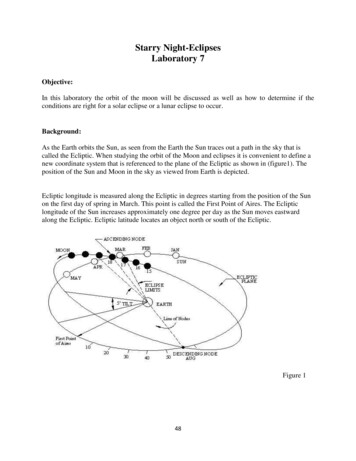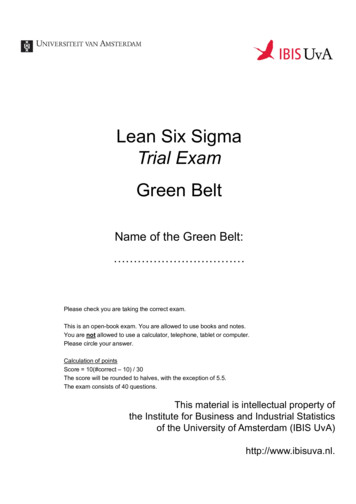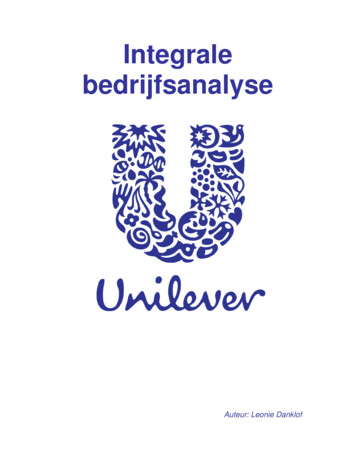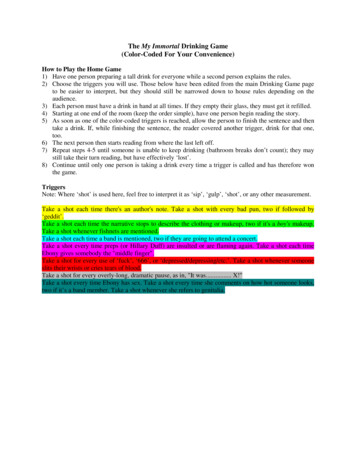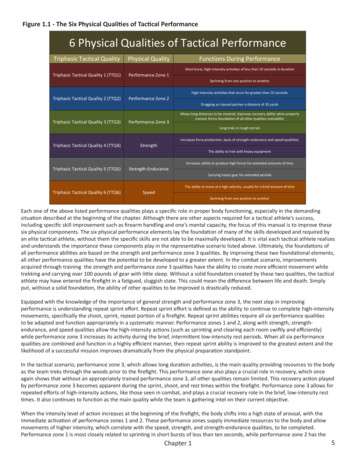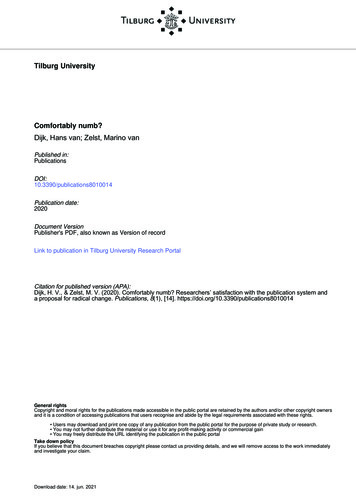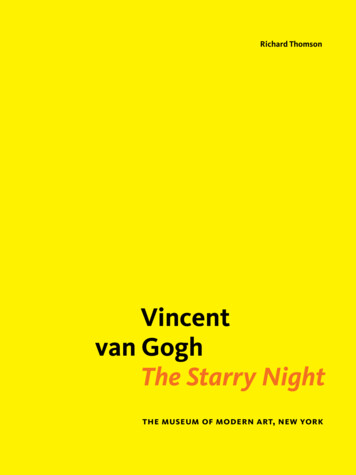
Transcription
Richard ThomsonVincentvan GoghThe Starry Nightthe museum of modern art, new york
The Starry Nightfig. 1. Vincent van Gogh. The Starry Night.1889. Oil on canvas, 29 36 1 4" (73.7 92 cm).The Museum of Modern Art, New York.Acquired through the Lillie P. Bliss Bequest2without doubt, vincent van gogh’s painting the starry night(fig. 1) is an iconic image of modern culture. One of the beacons of TheMuseum of Modern Art, every day it draws thousands of visitors whowant to gaze at it, be instructed about it, or be photographed in frontof it. The picture has a far-flung and flexible identity in our collectivemusée imaginaire, whether in material form decorating a tie or T-shirt,as a visual quotation in a book cover or caricature, or as a ubiquitouslyunderstood allusion to anguish in a sentimental popular song. StarryNight belongs in the front rank of the modern cultural vernacular.This is rather a surprising status to have beenachieved by a painting that was executed with neither fanfare nor muchexplanation in Van Gogh’s own correspondence, that on reflection theartist found did not satisfy him, and that displeased his crucial supporterand primary critic, his brother Theo. Starry Night was painted in June1889, at a period of great complexity in Vincent’s life. Living at theasylum of Saint-Rémy in the south of France, a Dutchman in Provence,he was cut off from his country, family, and fellow artists. His isolationwas enhanced by his state of health, psychologically fragile and erratic.Yet for all these taxing disadvantages, Van Gogh was determined tofulfill himself as an artist, the road that he had taken in 1880. The lettersthat he wrote in 1889, in the weeks and months preceding and following the painting of Starry Night, demonstrated his highly engagedunderstanding of art: in terms of his own picture-making practice, andin relation to the contemporary artists whom he admired and the art ofthe past that he revered. Van Gogh’s thinking—whether articulatedpictorially in paintings and drawings or verbally in correspondence—was fixated on art.3
During the summer and fall of 1889 Van Gogh wasdeeply concerned with style. This was the word he used in his correspondence, and it had many ramifications for him. Style touched notonly the appearance of his paintings, how they were crafted and colored,his own personal handwriting of touch and texture in response to hismotif, but also what they represented and how—even where and underwhat conditions—they should be made. Vincent’s conscious grapplingwith problems of style and method was played out in his work, and hisalternating experiments with pictures done in front of nature and fromthe imagination were means of resolving them in practice. He alsomade replicas of canvases that he felt had been successful and, particularly in the later part of the year, made painted copies of the black-andwhite prints Theo sent him after artists he admired—among themRembrandt, Eugène Delacroix, and Jean-François Millet—by paintingvariations that added his own interpretative color to their originalcompositions. If by copying Van Gogh maintained a stylistic dialoguewith past art, his conversation with his contemporaries in the avantgarde seems to have been constant in his own mind. This is apparent inhis letters to Theo, in which what Vincent imagines Paul Gauguin andEmile Bernard are doing in their current work is constantly if speculatively invoked. It surfaces too in the practical decisions he made aboutwhether or not to exhibit in Paris with Gauguin’s group in its renegadeexhibition at the Café Volpini on the site of the grand UniversalExhibition staged that summer, or what to exhibit at the Salon desIndépendants in September.Whether it was negotiating his position in theParisian avant-garde at a distance of four hundred miles or decidingwhat to paint in the landscape at Saint-Rémy, Van Gogh’s incessant andself-critical deliberation about artistic practice and strategy marks himout as an artist determined to identify and articulate his own style, aterm that had another dimension for him. For another word that occursfrequently in his correspondence during this period is consolation. Bythis Vincent seems to have meant both the cathartic satisfaction ofcrafting a harmonious work of art and the sense of intimate communication that the work secures between artist and spectator.1 Starry NightThe journey that had made Vincent van Gogh an artist and had led himto Saint-Rémy was a long and convoluted one.2 Born in 1853, the son ofa Protestant pastor in the southern Netherlands, at seventeen he hadfollowed his successful uncle Vincent into the firm of Goupil, one of theleading art dealers of the period, with branches in several Europeancities. Having worked for the company in The Hague, London, and,briefly, Paris, in 1876 Van Gogh, increasingly preoccupied with religion,left the art trade, first to work as a teacher in England, then to studytheology in Amsterdam, and next to work as a missionary among theminers of the Belgian coalfields. Sacked for overzealousness, in 1880Vincent decided to train himself to be an artist, and his younger brotherTheo, by now himself employed by Goupil in Paris, agreed to subsidizethis new vocation. Although Van Gogh henceforth devoted himselfsingle-mindedly to art, he remained deeply marked by his Christianheritage, seeking in unorthodox and conflicted ways to engage his lifeand work with moral values, such as honesty and brotherhood, yetbringing himself into conflict with the conservative certainties of hisfather. After five years working in his native Netherlands, Vincent, looking to improve his drawing, traveled first to Belgium, where over thewinter of 1885–86 he worked at the Academy of Fine Art in Antwerp,and then in March 1886 to Paris. During his two years in the Frenchcapital his work developed dramatically. Having access to the richnessof the Paris museums and the diversity of its art market, studying atthe teaching studio of Fernand Cormon—where he met younger artistssuch as Louis Anquetin, Henri de Toulouse-Lautrec, and Bernard—collecting Japanese prints, and becoming increasingly engaged with anew generation of artists and dealers that he characterized as the petitboulevard, differentiating them from the more established artisticcircles of Paris’s central boulevards; all these opportunities contributedto his artistic progress. His color in particular became brighter and his4vincent van gogh: the starry nightshould be considered in such contexts, and placed squarely within theambitions, anxieties, and achievements of an extraordinary artistmaking work in demanding isolation.5
touch more varied. But Van Gogh found the metropolis frantic anddebilitating, and in February 1888 he decamped southward for Arles, asmall historic city on the banks of the river Rhône, some thirty milesfrom the Mediterranean coast of France.Arles appealed to Van Gogh. With its population of23,000 it was congenial in scale, and he found friends: the postal clerkRoulin (fig. 2) and the café proprietor Ginoux. While the town providedmotifs, such as public thoroughfares, cafés, and parks, the outlyingcountryside offered a contrast, its high-intensity agriculture on the flat,canalized plain of La Crau suggesting welcome analogies with Vincent’snative Netherlands and the fantasy vision of Japan he had derived fromthe study of ukiyo-e prints. At the same time the strong sun and fierceheat of the southern climate presented him with new practical challenges, the sunlight encouraginghim to intensify his color rangeand the winds of the mistral, thepowerful wind that blows southdown the Rhône valley, makingwork outdoors sometimes verydifficult. If at first working alone atArles allowed Vincent the opportunity to gradually absorb into hisown practice the lessons aboutvariegated touch, simplified drawing, and complementary color hehad learned in Paris, he came toyearn for artistic exchange andwas relieved when in Octoberfig. 2. Vincent van Gogh. Portrait of Joseph Roulin.Gauguin, sponsored by Theo, came1889. Oil on canvas, 25 21 " (64.4 55.2 cm). Theto share his accommodation. AfterMuseum of Modern Art, New York. Gift of Mr. and Mrs.two months, however, their relaWilliam A. M. Burden, Mr. and Mrs. Paul Rosenberg,Nelson A. Rockefeller, Mr. and Mrs. Armand P. Bartos,tionship had splintered. TheirThe Sidney and Harriet Janis Collection, Mr. anddifferencesvaried from the banallyMrs. Werner E. Josten, and Loula D. Lasker Bequest(all by exchange)domestic—Gauguin was tidy, VanGogh chaotic—to the professionally36834artistic, in both matters of taste—Gauguin admired Ingres and EdgarDegas, Van Gogh Delacroix andAdolphe Monticelli—and of practice. For Gauguin favored paintingwith flat surfaces and woventextures, Van Gogh palpablefacture and complementary colors;above all, Gauguin had recentlybegun to insist upon working frommemory and imagination, whileVan Gogh found it very hard topaint without his subject in frontof him, however much he mightexaggerate form and color. The rift,when it came, either caused or was fig. 3. Vincent van Gogh. Self-Portrait withexacerbated by a psychological Bandaged Ear. 1889. Oil on canvas, 23 19 "(60.5 50 cm). The Samuel Courtauld Trust,crisis for Van Gogh, during which Courtauld Institute of Art Gallery, Londonhe mutilated his left ear (fig. 3).While this may not have been the first manifestation of his condition—Van Gogh had consulted a psychologist in The Hague around 1879–80—and we may never have an exact diagnosis (acute intermittent porphyria,epilepsy, alcoholism, and hereditary factors have all been suggested),the incident in late December 1888 started the spiraling cycle of lengthening and incapacitating crises interspersed with periods of stabilityand work that ultimately led to Van Gogh’s suicide at Auvers-sur-Oisein July 1890.Having spent the early months of 1889 in the publichospital at Arles, Van Gogh decided voluntarily to enter himself intothe asylum at Saint-Rémy, some fifteen miles to the northeast.3 SaintRémy was then a modest little town of fewer than 6,000 inhabitants. Tothe north the flat terrain between the Rhône and Durance rivers stretchesa dozen miles northward to the great medieval city of Avignon, and SaintRémy itself is situated on a long slope that leads up from this plain tothe dramatic rocky peaks of the Alpilles, or little Alps, an independent13vincent van gogh: the starry night1611167
range of small but craggily crenellated hills to the south of the town.The asylum of Saint-Paul-de-Mausole (fig. 4), a well-established institution run by Dr. Auguste Peyron, was accommodated in a complex offormer ecclesiastical buildings—comprising housing blocks, achurch, and a large enclosedgarden—at the very foot of theAlpilles and about a mile’s walkdownhill to the town. Van Goghentered it on May 8. At the asylumVincent was given supervision,regular meals, and some treatment—essentially hydrotherapy;he took a two-hour bath twice afig. 4. Advertisement for Saint-Paul-de-Mausole asylumweek—but he chose not to askPeyron about his condition or progress. Above all, staying at the asylumwas intended to provide the artist with a haven of tranquillity.Van Gogh’s work at Saint-Rémy had to accept certainrestrictions. Some were imposed by the asylum’s regime. To begin with,Peyron kept Vincent under observation, and initially he was onlyallowed to paint and draw within the confines of the institution. OnMay 26 Peyron wrote to Theo in Paris that he was now prepared toallow the painter into the surrounding countryside.4 However, he neverseems to have worked more than a few hundred yards from the asylumand it is likely that he was always accompanied, as was the case whenhe walked down to Saint-Rémy in early June, when he found beingamong many people disturbing.5 Other limitations were enforced by hisstate of health. For the first two months—during which time heexecuted Starry Night—Van Gogh was stable and Peyron was contentwith his progress. However, about July 16 he suffered another crisis, andwas incapacitated for about five weeks. This alternating pattern ofstability and distress lasted until Van Gogh left Saint-Rémy for Paris,and then for Auvers, on May 16, 1890. Further limitations the artistchose for himself. He did not paint his fellow patients, except as schematic figures in paintings of the gardens, although he made portraits of8one of the warders and his wife. (The copying of works by other artiststhat Vincent began in fall 1889 was in part to sharpen his drawing of thefigure.) He also opted to ignore the remains of Glanum, a Roman townreplete with triumphal arch within a couple of minutes’ walk from theasylum, just as in Arles he had paid no close attention to the greatRomanesque church of St. Trophime. Essentially, these various limitations restricted Van Gogh’s range of subjects: few portraits, still lifes,copies, only the localized landscape, rarely ventured social subjectssuch as the streets of Saint-Rémy. But—to use contemporary painters’terms—if he was limited in terms of sujet (subject), he could still exploreeffet (conditions of weather or light).One effet that had interested Van Gogh at Arles wasnight. He had undertaken nocturnal effects before; for example, thePotato-Eaters, painted in May 1885 prior to leaving The Netherlands,represented a family of peasants eating their evening meal in a darkroom illuminated by lamplight. But at Arles the idea of painting thenight sky became a haunting one. A couple of months after arriving inArles, on April 9, 1888, he wrote to Theo that “I must also have a starrynight with cypresses, or perhaps above all a field of ripe corn; there aresome wonderful nights here.”6 However, it was not until the end of thesummer that he began to accumulate canvases of nocturnal subjects.They form a somewhat hybrid group, including two sunset scenes ofmen unloading barges on the banks of the Rhône (fig. 5), a portrait ofth
Night belongs in the front rank of the modern cultural vernacular. This is rather a surprising status to have been achieved by a painting that was executed with neither fanfare nor much explanation in Van Gogh’s own correspondence, that on reflection the artist found did not satisfy him, and that displeased his crucial supporter and primary critic, his brother Theo. Starry Night was painted .
